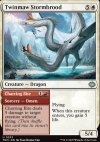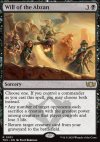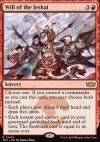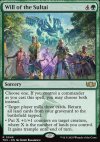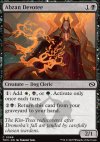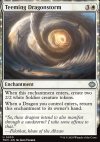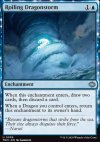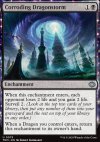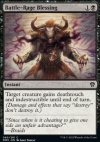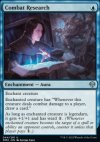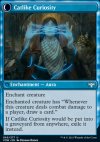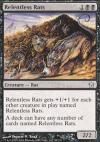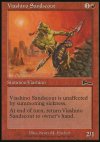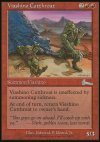|

MV anecdotes
| 47 anecdotes trouvées |   |
La carte Undergrowth Leopard est une réimpression fonctionnelle de Voracious Varmint, à part pour le type de créature.
La carte Frontier Bivouac, dans sa version de l'édition Tarkir: Dragonstorm, évoque par son texte d'ambiance ("a fresh catch", "du poisson frais") et son illustration (un pêcheur avec son petit seau) une activité de pêche pour le peuple Temur.
Or, si originellement le clan tel que dépeint dans l'édition Khans of Tarkir était plutôt des chasseurs-cueilleurs, en harmonie avec l'identité couleur

 de leur wedge (voir aussi cette anecdote), se nourrissant de poisson comme l'atteste l'illustration de la carte Feed the Clan tout comme de gibier, le peuple Temur a ensuite été accaparé par la vénerie au moment des événements de l'édition Dragons of Tarkir, le meilleur de leur chasse étant alors réservé pour Dragonlord Atarka, comme l'atteste Dragonlord's Servant ou encore le texte d'ambiance de Berserkers' Onslaught, en conformité avec le "lore" de la paire de couleurs
de leur wedge (voir aussi cette anecdote), se nourrissant de poisson comme l'atteste l'illustration de la carte Feed the Clan tout comme de gibier, le peuple Temur a ensuite été accaparé par la vénerie au moment des événements de l'édition Dragons of Tarkir, le meilleur de leur chasse étant alors réservé pour Dragonlord Atarka, comme l'atteste Dragonlord's Servant ou encore le texte d'ambiance de Berserkers' Onslaught, en conformité avec le "lore" de la paire de couleurs 
 de la seigneur-dragon.
de la seigneur-dragon.
En l'absence d'Atarka et avec le retour à leur identité couleur originelle, les Temurs se livrent de nouveau à leur activité de pêche que nous pouvons ainsi observer, en plus de celle de chasse qui avait perduré.
Or, si originellement le clan tel que dépeint dans l'édition Khans of Tarkir était plutôt des chasseurs-cueilleurs, en harmonie avec l'identité couleur


 de leur wedge (voir aussi cette anecdote), se nourrissant de poisson comme l'atteste l'illustration de la carte Feed the Clan tout comme de gibier, le peuple Temur a ensuite été accaparé par la vénerie au moment des événements de l'édition Dragons of Tarkir, le meilleur de leur chasse étant alors réservé pour Dragonlord Atarka, comme l'atteste Dragonlord's Servant ou encore le texte d'ambiance de Berserkers' Onslaught, en conformité avec le "lore" de la paire de couleurs
de leur wedge (voir aussi cette anecdote), se nourrissant de poisson comme l'atteste l'illustration de la carte Feed the Clan tout comme de gibier, le peuple Temur a ensuite été accaparé par la vénerie au moment des événements de l'édition Dragons of Tarkir, le meilleur de leur chasse étant alors réservé pour Dragonlord Atarka, comme l'atteste Dragonlord's Servant ou encore le texte d'ambiance de Berserkers' Onslaught, en conformité avec le "lore" de la paire de couleurs 
 de la seigneur-dragon.
de la seigneur-dragon.En l'absence d'Atarka et avec le retour à leur identité couleur originelle, les Temurs se livrent de nouveau à leur activité de pêche que nous pouvons ainsi observer, en plus de celle de chasse qui avait perduré.
Source a écrit :
The Temur
The Temur are a semi-nomadic people who thrive in the northern mountain terrain, living in concert with their environment. The Temur way of life is adapted to the long, freezing winters. They are expert hunters, gatherers, and herders, forming close bonds with animal companions that work alongside them.
[...]
The Temur are semi-nomadic, transitioning during the year between villages and mobile camps. Winter, spring, and fall are generally spent in villages, while the summers are their most mobile time of year, as they move in more temporary camps to prevent overhunting or grazing in a single area.
[...]
Civilians occupy many roles within the Temur. Hunters, gatherers, and herders are most common as direct supports to the wellbeing and lifestyle of the clan, focused on keeping them fed and sheltered. They are careful to ensure they maintain balance in the resources of the land, taking only what is needed and using all that they hunt or gather.
[...]
Hunting, horticulture, and animal husbandry – The northern climate is less hospitable to farming, so the Temur practice robust animal husbandry, bringing herds with them as they travel. They do some agriculture near their semi-permanent settlements and focus more on foraging and cultivation of what is already growing to maintain populations for future gathering. In addition, the Temur are proficient fishers, fishing from frozen lakes in the winter as an additional source of food in the coldest seasons.
The Temur are a semi-nomadic people who thrive in the northern mountain terrain, living in concert with their environment. The Temur way of life is adapted to the long, freezing winters. They are expert hunters, gatherers, and herders, forming close bonds with animal companions that work alongside them.
[...]
The Temur are semi-nomadic, transitioning during the year between villages and mobile camps. Winter, spring, and fall are generally spent in villages, while the summers are their most mobile time of year, as they move in more temporary camps to prevent overhunting or grazing in a single area.
[...]
Civilians occupy many roles within the Temur. Hunters, gatherers, and herders are most common as direct supports to the wellbeing and lifestyle of the clan, focused on keeping them fed and sheltered. They are careful to ensure they maintain balance in the resources of the land, taking only what is needed and using all that they hunt or gather.
[...]
Hunting, horticulture, and animal husbandry – The northern climate is less hospitable to farming, so the Temur practice robust animal husbandry, bringing herds with them as they travel. They do some agriculture near their semi-permanent settlements and focus more on foraging and cultivation of what is already growing to maintain populations for future gathering. In addition, the Temur are proficient fishers, fishing from frozen lakes in the winter as an additional source of food in the coldest seasons.
Les cinq cartes Twinmaw Stormbrood, Whirlwing Stormbrood, Purging Stormbrood, Runescale Stormbrood et Disruptive Stormbrood, de l'édition Tarkir: Dragonstorm, forment un cycle appelé "Stormbrood" de dragons, chacun possédant un Omen d'une couleur ennemie.
Source ("There are two cycles of Dragons with Omen spells, one at common where the Dragons are the same color as the Omen spell and one at uncommon on monocolor Dragons with an Omen spell of the Dragon's enemy color. [...] The two-color cards in a wedge set want to be enemy-color cards, as that's what is supported in a wedge-focused Limited environment. Players can start with an enemy-color pair, allowing them to move into one of two three-color wedge factions. If you take an ally-color pair, that card can only go in one wedge. [...] Uncommon [...] A cycle of monocolor Dragons with an enemy-color Omen spell")
Source ("There are two cycles of Dragons with Omen spells, one at common where the Dragons are the same color as the Omen spell and one at uncommon on monocolor Dragons with an Omen spell of the Dragon's enemy color. [...] The two-color cards in a wedge set want to be enemy-color cards, as that's what is supported in a wedge-focused Limited environment. Players can start with an enemy-color pair, allowing them to move into one of two three-color wedge factions. If you take an ally-color pair, that card can only go in one wedge. [...] Uncommon [...] A cycle of monocolor Dragons with an enemy-color Omen spell")
Les cinq cartes Will of the Abzan, Will of the Jeskai, Will of the Sultai, Will of the Mardu et Will of the Temur, de l'édition Tarkir: Dragonstorm Commander Decks, forment un cycle appelé "Will" d'éphémères/rituels, chacun étant rattaché à un des clans de Tarkir, respectivement : Abzan, Jeskai, Sultai, Mardu et Temur (voir cette anecdote).
Ce cycle est inspiré d'un autre cycle paru dans l'édition Commander Legends (voir cette anecdote).
Ce cycle est inspiré d'un autre cycle paru dans l'édition Commander Legends (voir cette anecdote).
Les cinq cartes Great Arashin City, Cori Mountain Monastery, Kishla Village, Dalkovan Encampment et Mistrise Village, de l'édition Tarkir: Dragonstorm, forment un cycle de terrains rattachés aux wedges des clans de Tarkir, respectivement : Abzan, Jeskai, Sultai, Mardu et Temur (voir cette anecdote).
Les cinq cartes Abzan Devotee, Jeskai Devotee, Sultai Devotee, Mardu Devotee et Temur Devotee, de l'édition Tarkir: Dragonstorm, forment un cycle appelé "Devotee" de créatures avec une capacité de mana dont les couleurs sont rattachées aux wedges des clans de Tarkir, respectivement : Abzan, Jeskai, Sultai, Mardu et Temur (voir cette anecdote).
Source (The Common Devotee Cycle - "The goal of the Devotees is to help your three-color deck when you're missing one of your colors without making it too easy to splash a fourth color. Also, Set Design was interested in finding ways to provide mana that played to the board, meaning they helped you advance toward winning the game rather than taking a turn off to play a mana source. [...] After trying various things, the Set Design team discovered that once-per-turn color washing (turning one color of mana into another) did the best job. [...]")
Source (The Common Devotee Cycle - "The goal of the Devotees is to help your three-color deck when you're missing one of your colors without making it too easy to splash a fourth color. Also, Set Design was interested in finding ways to provide mana that played to the board, meaning they helped you advance toward winning the game rather than taking a turn off to play a mana source. [...] After trying various things, the Set Design team discovered that once-per-turn color washing (turning one color of mana into another) did the best job. [...]")
Les cinq cartes Teeming Dragonstorm, Roiling Dragonstorm, Corroding Dragonstorm, Breaching Dragonstorm et Encroaching Dragonstorm, de l'édition Tarkir: Dragonstorm, forment un cycle appelé "Dragonstorm".
Ce cycle est inspiré d'un autre cycle paru dans l'édition Amonkhet (voir cette anecdote).
Source 1 ("We knew that the dragonstorms were going to play an important role in the set's story [...], so we wanted to use them to enable Dragon typal decks. [...] Set Design would end up changing these to enchantment cards that mimicked the Trial cycle of enchantments from Amonkhet. [...]") - Source 2 (The Uncommon Dragonstorm Cycle)
Ce cycle est inspiré d'un autre cycle paru dans l'édition Amonkhet (voir cette anecdote).
Source 1 ("We knew that the dragonstorms were going to play an important role in the set's story [...], so we wanted to use them to enable Dragon typal decks. [...] Set Design would end up changing these to enchantment cards that mimicked the Trial cycle of enchantments from Amonkhet. [...]") - Source 2 (The Uncommon Dragonstorm Cycle)
Les cinq cartes Barrensteppe Siege, Frostcliff Siege, Hollowmurk Siege, Windcrag Siege et Glacierwood Siege, de l'édition Tarkir: Dragonstorm, forment un cycle appelé "- Siege".
Les mots d'ancrage associés à chacun des modes des cartes correspondent aux deux clans de Tarkir dont on peut obtenir le wedge correspondant en ajoutant une troisième couleur qui n'est pas l'alliée commune des deux couleurs du coût de mana (sinon on obtiendrait un éclat), à savoir : Abzan, Jeskai, Sultai, Mardu et Temur (voir cette anecdote).
Ce cycle est inspiré d'un autre cycle paru dans l'édition Fate Reforged (voir cette anecdote).
Source ("The two-color cards in a wedge set want to be enemy-color cards, as that's what is supported in a wedge-focused Limited environment. Players can start with an enemy-color pair, allowing them to move into one of two three-color wedge factions. If you take an ally-color pair, that card can only go in one wedge.")
Les mots d'ancrage associés à chacun des modes des cartes correspondent aux deux clans de Tarkir dont on peut obtenir le wedge correspondant en ajoutant une troisième couleur qui n'est pas l'alliée commune des deux couleurs du coût de mana (sinon on obtiendrait un éclat), à savoir : Abzan, Jeskai, Sultai, Mardu et Temur (voir cette anecdote).
Ce cycle est inspiré d'un autre cycle paru dans l'édition Fate Reforged (voir cette anecdote).
Source ("The two-color cards in a wedge set want to be enemy-color cards, as that's what is supported in a wedge-focused Limited environment. Players can start with an enemy-color pair, allowing them to move into one of two three-color wedge factions. If you take an ally-color pair, that card can only go in one wedge.")
Les cinq cartes Betor, Kin to All, Shiko, Paragon of the Way, Teval, Arbiter of Virtue, Neriv, Heart of the Storm et Ureni, the Song Unending, de l'édition Tarkir: Dragonstorm, ainsi que les cinq cartes Betor, Ancestor's Voice, Shiko and Narset, Unified, Teval, the Balanced Scale, Neriv, Crackling Vanguard et Ureni of the Unwritten, de l'édition Tarkir: Dragonstorm Commander Decks, forment un cycle de dragons esprits légendaires, chacun étant rattaché à un des wedges des clans de Tarkir, respectivement : Abzan, Jeskai, Sultai, Mardu et Temur (voir cette anecdote).
Source ("The two-color cards in a wedge set want to be enemy-color cards, as that's what is supported in a wedge-focused Limited environment. [...] That meant if we put dragonlords in the set, they would have to either be monocolor or three-color creatures. [...] The Creative team decided they would rather create new three-color Dragons and five Spirit Dragons that help the clans. [...] A mythic rare cycle of legendary three-color Spirit Dragons")
Source ("The two-color cards in a wedge set want to be enemy-color cards, as that's what is supported in a wedge-focused Limited environment. [...] That meant if we put dragonlords in the set, they would have to either be monocolor or three-color creatures. [...] The Creative team decided they would rather create new three-color Dragons and five Spirit Dragons that help the clans. [...] A mythic rare cycle of legendary three-color Spirit Dragons")
La carte Skirmish Rhino est une référence à Siege Rhino de par son nom, son identité couleur, son type de créature et le rapport de ses force et endurance et de l'effet de sa capacité déclenchée à son coût de mana (une escarmouche est moins importante qu'un siège...).
La carte Offer Immortality est une réimpression fonctionnelle de Battle-Rage Blessing.
La carte Alesha's Legacy en est une version revisitée.
La carte Alesha's Legacy en est une version revisitée.
Le nom anglais de la carte Stormscale Scion et sa capacité Storm font référence à la "Storm Scale", une échelle semi-officielle utilisée par les concepteurs du jeu pour déterminer la probabilité qu'une mécanique fasse son retour dans une édition légale en format Standard. L'échelle va de 1 pour les mécaniques les plus probables à 10 pour les plus improbables. La mécanique Storm était classée 10.
Source 1 ("Many years ago on my blog (Blogatog on Tumblr), I created the Storm Scale as a fun way to predict the likelihood of certain mechanics or other features returning to a premier set (something legal in Standard). I named it the Storm Scale after the mechanic storm, which I felt was unlikely to return to Standard.") - Source 2 (Stormscale Scion - "On September 23, 2012, I received the following question: 'Where does cascade stand on chance of reprinted, on a scale of storm-10?' And my response: 'On the Storm scale (the chance of being reprinted: 1 - cycling, 10 - storm): 3.' [...] Before I knew it, I was answering a huge number of questions about the Storm Scale. The popularity of the Storm Scale then led to a host of other scales [...]") - Source 3
Source 1 ("Many years ago on my blog (Blogatog on Tumblr), I created the Storm Scale as a fun way to predict the likelihood of certain mechanics or other features returning to a premier set (something legal in Standard). I named it the Storm Scale after the mechanic storm, which I felt was unlikely to return to Standard.") - Source 2 (Stormscale Scion - "On September 23, 2012, I received the following question: 'Where does cascade stand on chance of reprinted, on a scale of storm-10?' And my response: 'On the Storm scale (the chance of being reprinted: 1 - cycling, 10 - storm): 3.' [...] Before I knew it, I was answering a huge number of questions about the Storm Scale. The popularity of the Storm Scale then led to a host of other scales [...]") - Source 3
Les mécaniques des cartes Combat Research, Catlike Curiosity, A-Catlike Curiosity, Curious Obsession, Snake Umbra, Ophidian Eye, Sixth Sense, Keen Sense, Staggering Insight et Sleeper's Robe, ainsi que celles des cartes Acquisition Octopus, Goggles of Night, A-Goggles of Night, Rogue's Gloves, Mask of Riddles et Sword of Fire and Ice, sont inspirées de celle de la carte Curiosity.
De nombreuses créatures intègrent cette mécanique directement, sans avoir recours à une aura, un équipement ou encore un enchantement ou un artefact tels que Frostcliff Siege, Bottomless Pool / Locker Room, Enduring Curiosity, Reconnaissance Mission, Coastal Piracy, The Indomitable ou Bident of Thassa.
Search ~ Type : Aura + Couleurs : ou
ou  avec effet Curiosity - Search ~ Type : Equipment avec effet Curiosity - Source ("[...] an ability that R&D calls "curiosity" (a saboteur draw trigger). Curiosity is primary in blue and secondary in green.")
avec effet Curiosity - Search ~ Type : Equipment avec effet Curiosity - Source ("[...] an ability that R&D calls "curiosity" (a saboteur draw trigger). Curiosity is primary in blue and secondary in green.")
De nombreuses créatures intègrent cette mécanique directement, sans avoir recours à une aura, un équipement ou encore un enchantement ou un artefact tels que Frostcliff Siege, Bottomless Pool / Locker Room, Enduring Curiosity, Reconnaissance Mission, Coastal Piracy, The Indomitable ou Bident of Thassa.
Search ~ Type : Aura + Couleurs :
 ou
ou  avec effet Curiosity - Search ~ Type : Equipment avec effet Curiosity - Source ("[...] an ability that R&D calls "curiosity" (a saboteur draw trigger). Curiosity is primary in blue and secondary in green.")
avec effet Curiosity - Search ~ Type : Equipment avec effet Curiosity - Source ("[...] an ability that R&D calls "curiosity" (a saboteur draw trigger). Curiosity is primary in blue and secondary in green.")Les cinq cartes Anafenza, the Foremost, Narset, Enlightened Master, Sidisi, Brood Tyrant, Zurgo Helmsmasher et Surrak Dragonclaw, de l'édition Khans of Tarkir, forment un cycle de créatures légendaires tricolores, chacune représentant le khan de son clan.
Au moment des événements de l'édition Tarkir: Dragonstorm, les khans des clans sont respectivement Felothar, Dawn of the Abzan, Narset, Jeskai Waymaster, Kotis, the Fangkeeper, Zurgo, Thunder's Decree et Eshki Dragonclaw ; les anciens khans Anafenza, Unyielding Lineage, Sidisi, Regent of the Mire et Surrak, Elusive Hunter ont une autre occupation au sein du clan.
Source 1 (Prose and Khans) - Source 2 (Defined clans - "Once we had five clans, we had to have a more balanced structure to match the color pie. Shards of Alara focused on three-color shards (a color and its two allies), but we'd never done a wedge-focused set (a color and its two enemies).") - Source 3 (Use of Multicolor - Legendary Wedge Creatures (Mythic Rare) - "[...] The set needs mythic rare warlords, and the clans are each three colors. This cycle of mythic rare legendary creatures was a no-brainer. [...] These were the leaders of each clan.")
Au moment des événements de l'édition Tarkir: Dragonstorm, les khans des clans sont respectivement Felothar, Dawn of the Abzan, Narset, Jeskai Waymaster, Kotis, the Fangkeeper, Zurgo, Thunder's Decree et Eshki Dragonclaw ; les anciens khans Anafenza, Unyielding Lineage, Sidisi, Regent of the Mire et Surrak, Elusive Hunter ont une autre occupation au sein du clan.
Source 1 (Prose and Khans) - Source 2 (Defined clans - "Once we had five clans, we had to have a more balanced structure to match the color pie. Shards of Alara focused on three-color shards (a color and its two allies), but we'd never done a wedge-focused set (a color and its two enemies).") - Source 3 (Use of Multicolor - Legendary Wedge Creatures (Mythic Rare) - "[...] The set needs mythic rare warlords, and the clans are each three colors. This cycle of mythic rare legendary creatures was a no-brainer. [...] These were the leaders of each clan.")
Source 1 a écrit :
The design worked as such: each clan was centered in a color and had one ally color and one enemy color, resulting in a tri-color wedge combination. Each clan was also tied to an attribute of the dragon, which the clan tried to emulate. Here's the breakdown:
Abzan
• WBG (centered in white)
• Dragon Attribute: Endurance
• Symbol: Scale of the Dragon
• Khan: Anafenza
Jeskai
• URW (centered in blue)
• Dragon Attribute: Cunning
• Symbol: Eye of the Dragon
• Khan: Narset
Sultai
• BGU (centered in black)
• Dragon Attribute: Ruthlessness
• Symbol: Fang of the Dragon
• Khan: Sidisi
Mardu
• RWB (centered in red)
• Dragon Attribute: Speed
• Symbol: Wing of the Dragon
• Khan: Zurgo
Temur
• GUR (centered in green)
• Dragon Attribute: Savagery
• Symbol: Claw of the Dragon
• Khan: Surrak
Abzan
• WBG (centered in white)
• Dragon Attribute: Endurance
• Symbol: Scale of the Dragon
• Khan: Anafenza
Jeskai
• URW (centered in blue)
• Dragon Attribute: Cunning
• Symbol: Eye of the Dragon
• Khan: Narset
Sultai
• BGU (centered in black)
• Dragon Attribute: Ruthlessness
• Symbol: Fang of the Dragon
• Khan: Sidisi
Mardu
• RWB (centered in red)
• Dragon Attribute: Speed
• Symbol: Wing of the Dragon
• Khan: Zurgo
Temur
• GUR (centered in green)
• Dragon Attribute: Savagery
• Symbol: Claw of the Dragon
• Khan: Surrak
Les cartes Humbling Elder et Cogwork Wrestler sont des réimpressions fonctionnelles de Brinebarrow Intruder, à part pour le type de créature.
Les cartes Web Up, Stormplain Detainment et Borrowed Time sont des réimpressions fonctionnelles de Banishing Light.
Les cartes Kheru Mind-Eater, Kheru Bloodsucker et Qarsi Revenant représentent l'unique vampire du Plan de Tarkir. Il fait référence aux Leyaks, créatures buveuses de sang de la mythologie balinaise et apparentées aux vampires, et à leur reine, Rangda ; elles sont représentées dotées d'une longue langue et de défenses.
Relentless Rats est la toute première carte imprimée mentionnant explicitement dans son texte que son nombre d'exemplaires n'est pas limité dans un deck. Elle s'inspire de la carte Plague Rats, qui, d'après une légende urbaine de Magic (voir cette anecdote), aurait été jouée à l'origine dans des decks en contenant un nombre non limité à 4 exemplaires.
Elle sera suivie ensuite par Shadowborn Apostle, Rat Colony, Persistent Petitioners, Dragon's Approach, Slime Against Humanity, Templar Knight, Hare Apparent et Tempest Hawk.
La carte Seven Dwarves (respectivement Nazgûl) présente quant à elle une variante, puisque son nombre d'exemplaires n'est pas illimité, mais limité à 7 (respectivement 9) au lieu de 4, en cohérence avec son flavor (voir cette anecdote).
Search ~ Texte : "A deck can have"
Elle sera suivie ensuite par Shadowborn Apostle, Rat Colony, Persistent Petitioners, Dragon's Approach, Slime Against Humanity, Templar Knight, Hare Apparent et Tempest Hawk.
La carte Seven Dwarves (respectivement Nazgûl) présente quant à elle une variante, puisque son nombre d'exemplaires n'est pas illimité, mais limité à 7 (respectivement 9) au lieu de 4, en cohérence avec son flavor (voir cette anecdote).
Search ~ Texte : "A deck can have"
Source 1 a écrit :
R&D tried numerous times to recapture the feel of Plague Rats, usually choosing to make the creatures bigger based on all your Rats.
Then during Fifth Dawn, we tried a new approach. What if the card just let you include as many copies as you wanted to play? [...] Once we had the "a deck may have any number" technology, we used it, although sparingly, on other cards. In the beginning, it was just used in black, although not always on Rats.
Ravnica Allegiance introduced the ability to blue, and Throne of Eldraine and Strixhaven would give it to red. The Council of Colors have talked about this. We've determined that, as long as the card fits into its color, any color can have access to "a deck may have any number" text.
In Throne of Eldraine, I wanted to capture the flavor of the seven dwarves. My original plan was to have exactly seven Dwarf cards in the set, but it took up too much space and was a little too much of a constraint on card concepting. My solution was to make one card called Seven Dwarves and then make a variant of the Relentless Rats template. Instead of letting you have any number, the card lets you have up to a specific number. In this case, seven.
We used that technology again in The Lord of the Rings: Tales of Middle-earth. We knew we wanted to have Nazgûl. They're one of the big villains in the story, but like the seven dwarves, we didn't have space to do nine. Luckily, we'd solved the problem already. Nazgûl uses the Seven Dwarves technology and becomes the first card where you can have up to nine copies in your deck.
Then during Fifth Dawn, we tried a new approach. What if the card just let you include as many copies as you wanted to play? [...] Once we had the "a deck may have any number" technology, we used it, although sparingly, on other cards. In the beginning, it was just used in black, although not always on Rats.
Ravnica Allegiance introduced the ability to blue, and Throne of Eldraine and Strixhaven would give it to red. The Council of Colors have talked about this. We've determined that, as long as the card fits into its color, any color can have access to "a deck may have any number" text.
In Throne of Eldraine, I wanted to capture the flavor of the seven dwarves. My original plan was to have exactly seven Dwarf cards in the set, but it took up too much space and was a little too much of a constraint on card concepting. My solution was to make one card called Seven Dwarves and then make a variant of the Relentless Rats template. Instead of letting you have any number, the card lets you have up to a specific number. In this case, seven.
We used that technology again in The Lord of the Rings: Tales of Middle-earth. We knew we wanted to have Nazgûl. They're one of the big villains in the story, but like the seven dwarves, we didn't have space to do nine. Luckily, we'd solved the problem already. Nazgûl uses the Seven Dwarves technology and becomes the first card where you can have up to nine copies in your deck.
Source 2 a écrit :
To appreciate the story of [Hare Apparent]'s design, we'll also begin this tale all the way back during Alpha design in August of 1993.
When Magic first came out, there was only one deck-construction rule: your deck had to be a minimum of 40 cards. Yes, 40 cards. Constructed decks being 60 cards wouldn't happen until Wizards formed the DCI (Duelists' Convocation International), and thus sanctioned play, in early 1994. The 40-card limit was kept for Limited play.
The lack of rules meant there weren't any card restrictions. A deck could have as many copies of a card as it wanted. Plague Rats was clearly designed with this in mind. One of the popular early decks had only three unique cards in it: Swamp , Dark Ritual , and Plague Rats.
Inspired by the popularity of Plague Rats , R&D kept making more Rats, and many of them got more powerful the more Rats you controlled.
During Fifth Dawn design, we decided it was time to redo Plague Rats as originally intended. We made three small changes. First, this card would be a 2/2 instead of a 1/1. Second, it'd cost 1BB instead of 2B. Third, we added "A deck can have any number of cards named CARDNAME." This would allow you to play as many as you wanted regardless of the restriction of the format you were playing.
R&D nicknamed the ability "relentless" after Relentless Rats . We used it sparingly. [...]
When Magic first came out, there was only one deck-construction rule: your deck had to be a minimum of 40 cards. Yes, 40 cards. Constructed decks being 60 cards wouldn't happen until Wizards formed the DCI (Duelists' Convocation International), and thus sanctioned play, in early 1994. The 40-card limit was kept for Limited play.
The lack of rules meant there weren't any card restrictions. A deck could have as many copies of a card as it wanted. Plague Rats was clearly designed with this in mind. One of the popular early decks had only three unique cards in it: Swamp , Dark Ritual , and Plague Rats.
Inspired by the popularity of Plague Rats , R&D kept making more Rats, and many of them got more powerful the more Rats you controlled.
During Fifth Dawn design, we decided it was time to redo Plague Rats as originally intended. We made three small changes. First, this card would be a 2/2 instead of a 1/1. Second, it'd cost 1BB instead of 2B. Third, we added "A deck can have any number of cards named CARDNAME." This would allow you to play as many as you wanted regardless of the restriction of the format you were playing.
R&D nicknamed the ability "relentless" after Relentless Rats . We used it sparingly. [...]
Les cartes Winternight Stories, Thirst for Discovery et Thirst for Meaning sont des références à Thirst for Knowledge de par leur nom pour certaines, leur coût de mana et leur effet.
Les cartes Witness of the Ages, Pilgrim of the Fires, Custodian of the Trove et Watcher of the Wayside représentent le même golem à différents moments de la chronologie de Tarkir.
Les trois cartes Tomb of the Spirit Dragon, Crucible of the Spirit Dragon et Haven of the Spirit Dragon forment un cycle de terrains appelé "Lands of the Spirit Dragon" et représentent le même endroit à différents moments de la chronologie du bloc Tarkir.
La carte Maelstrom of the Spirit Dragon parue ensuite fait référence à ce cycle.
La carte Maelstrom of the Spirit Dragon parue ensuite fait référence à ce cycle.
Les cartes Viashino Sandsprinter, Viashino Sandscout et Viashino Cutthroat, ainsi que Viashino Sandswimmer dans une certaine mesure, sont des références à Viashino Sandstalker de par leur nom, leur type de créature, leur capacité permettant de renvoyer la créature dans la main de son propriétaire et le rapport de leurs force et endurance à leur coût de mana.
Les cartes Glitterfang, Archwing Dragon, Reinforced Ronin et Fleeting Effigy parues ensuite (pour la plupart) partagent la même mécanique mais ne sont pas des Lézards.
Search ~ Texte : "At the beginning of " "end step, retu...
Les cartes Glitterfang, Archwing Dragon, Reinforced Ronin et Fleeting Effigy parues ensuite (pour la plupart) partagent la même mécanique mais ne sont pas des Lézards.
Search ~ Texte : "At the beginning of " "end step, retu...
Les cinq cartes Mox Pearl, Mox Sapphire, Mox Jet, Mox Ruby et Mox Emerald, auxquelles s'ajoutent Chrome Mox, Mox Opal et Mox Diamond, illustrées par Volkan Baga, forment un cycle d'illustrations (voir aussi cette anecdote).
La version normale de la carte Mox Jasper, de l'édition Tarkir: Dragonstorm et illustrée par Steven Belledin, fait référence à ce cycle de par la composition de son illustration, à savoir deux mains tenant ladite Mox vues en gros plan. À noter que l'illustration par le même artiste de la précédente Mox éditée, Mox Amber, ne reprend cependant pas cette composition.
La version normale de la carte Mox Jasper, de l'édition Tarkir: Dragonstorm et illustrée par Steven Belledin, fait référence à ce cycle de par la composition de son illustration, à savoir deux mains tenant ladite Mox vues en gros plan. À noter que l'illustration par le même artiste de la précédente Mox éditée, Mox Amber, ne reprend cependant pas cette composition.
| 47 anecdotes trouvées |   |






 Avatar: the Last Airbender
Avatar: the Last Airbender Spider-Man / Omenpaths
Spider-Man / Omenpaths Edge of Eternities
Edge of Eternities Final Fantasy
Final Fantasy Tarkir: Dragonstorm
Tarkir: Dragonstorm Aetherdrift
Aetherdrift Foundations
Foundations




